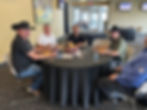Building Strategies: How to Combine Sustainability & Technology to Reduce Facility Overheads
A leadership discussion at Acrisure Stadium.

May 17, 2023
Why invest in smart buildings? What are the consequences of not investing—and simply doing nothing? How do we ensure the sustainable measures we implement become ingrained into our daily operations?
These were some of the executive themes presented at the DES client event “Building Strategies” at Acrisure Stadium. Bob Dagostino, president and founder of DES, spoke to the current landscape, “We are at an historical moment,” he stated. “A time of change. If business leadership does not get in front of the changes, we’ll quickly lose our competitive edge and become outdated.”
What are the shifting sands of the current competitive landscape?
Simply put, they are scarcity of labor, a societal awareness of environmental impact, and a breathtaking advancement in technology. These all come into sharp relief within the building environment. Facilities are having immense difficulties in filling front-line maintenance positions while building tenants and occupants are expecting concierge service. They want clean bathrooms, well-maintained facilities, easy-to-access technology, and a building owner or employer committed to green initiatives. Consequently, Wall Street is predicting a rise in “carbon stranded” buildings—buildings that fail to meet accepted standards and fail to be leased at competitive rates.
From our perspective, sustainability is an approach that integrates energy efficiency with technology deftness. It combines energy-saving best practices with a holistic technology network, resulting in a system that is easy to operate, saves on repetitive labor, and ensures long-term viability.
Jeff Corbett, DES technical engineer, walked the audience through several use cases:
Daylight Integrations: Daylight is the world’s daily gift to mankind. Yet, many workplaces simply do not integrate the light that floods through their windows with the building lighting systems. Programming electronic shades to rise and fall with the sunlight’s natural patterns, adjusting overhead lighting in sync with desired light intensity, and of course switching out those fluorescents to LEDs, creates a strategic and sustainable approach to building illumination.
IoT Sensors and Workflows: Sensors nowadays can do just about anything. They detect movement, temperature, proximity and more. When you combine sensor data with automated workflows, you create a superpower! For example, a sensor in a bathroom paper dispenser alerts facilities that it is empty. A work order is automatically created to order more supplies. Now, think of the cost savings: your maintenance crew only restocks the bathroom paper when alerted, and the repetitive tasking is automated. Calculate these costs at scale, and you have accrued real savings that not only affect the bottom line but satisfies the building occupants and saves on needless energy consumption.
Indoor Air Quality: Research is steadily emerging on the effects of poor air quality on optimal brain functioning. Quite literally, a healthier building starts with healthy air—air with low counts of particulate matter and CO2. This can be easily detected through air quality monitoring, yet it can only be successfully mitigated through a technology integration with your remediation strategy: whether that is automated adjustments to the HVAC system or alerts to open the windows. Once again, the result is a building that meets environmental regulations and attracts high-value tenants and employees.
Like all initiatives, a sustainable building strategy requires a degree of capital investment. Scot MacTaggart, DES Chief Innovation Officer, outlined resources that calculate your anticipated energy savings, avenues to implementing an affordable technology infrastructure, and incentivizing techniques to get your key personnel on board with your vision.
The capstone presentation was from accountancy firm KBKG. They pinpointed which building upgrades qualify for the 179D sustainability tax incentive and how new changes in the tax code, starting in 2023, will increase the deduction from $1.88/sf to $5.00/sf of building area.
To give an example: A 215,000 sf building switches out all their fluorescent lighting to LEDs, installs new lighting controls and upgrades the roof insulation. They calculate a 37% energy savings and are eligible for $795,000 in 179D tax deduction.
In a stroke of providence—arguably in response to our embrace of sustainable initiatives— the weather was gloriously sunny. We concluded the event with a backstage tour of Acrisure Stadium and a game of catch on the field, shadowed by the scoreboard emblazoned with the DES logo.
Next steps for you:
· Download our Smart Building infographic here.
· Contact us for a discussion














